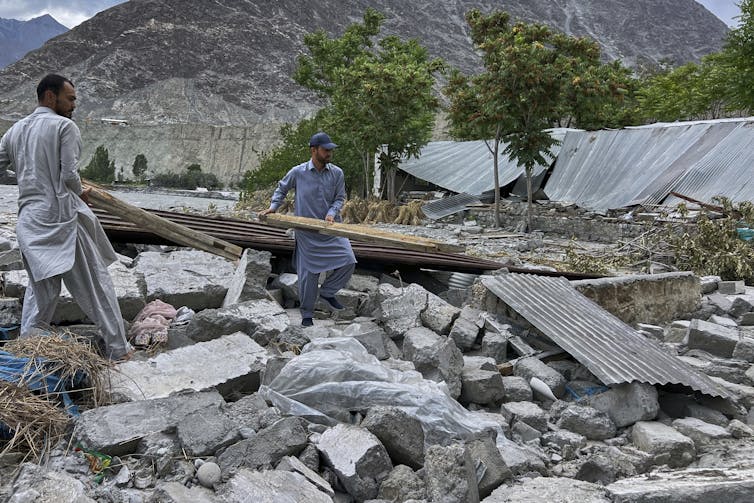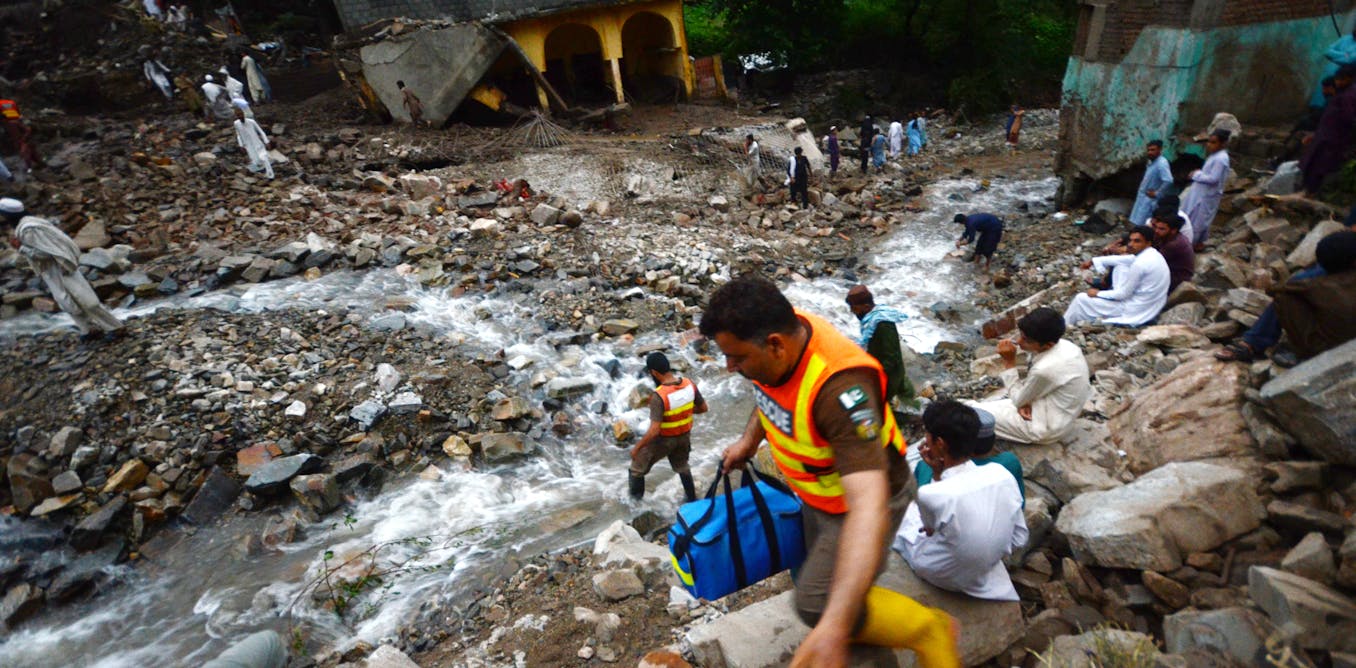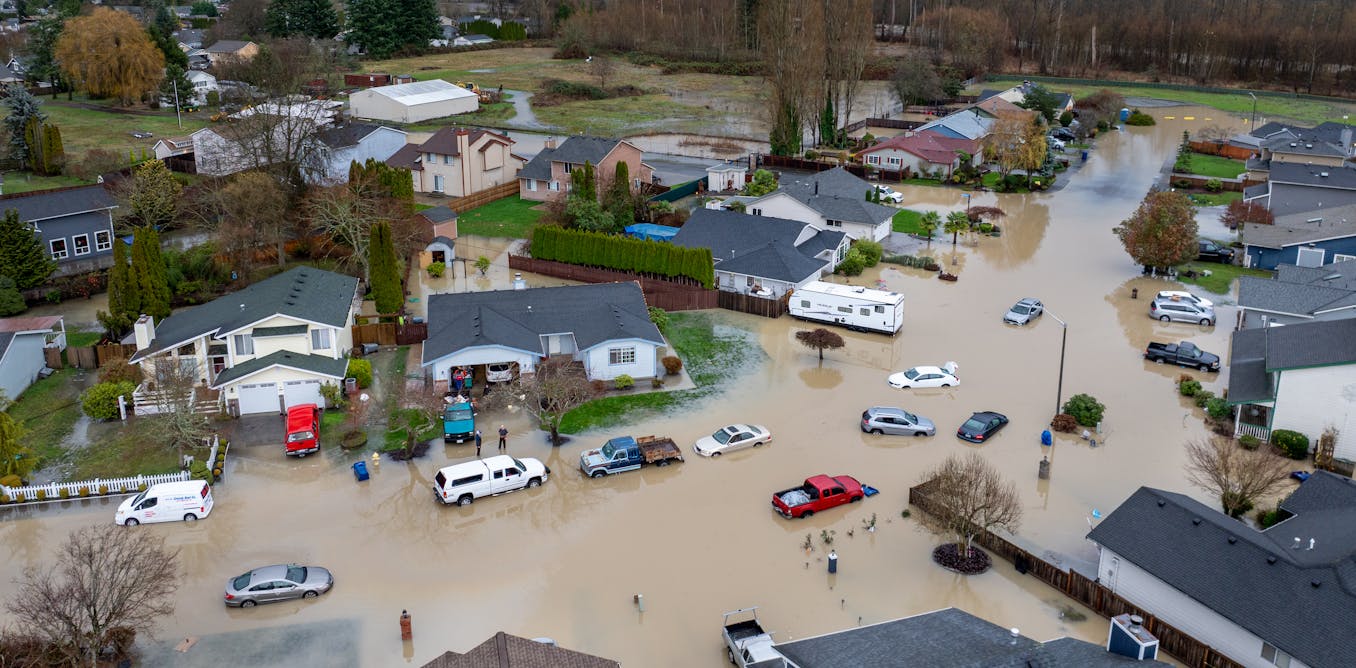Farmers in South Asia rely on the summer monsoon’s rainfall, but extreme monsoon rains in recent years have been destructive and deadly.
Since July, flooding during the 2025 summer monsoon has killed more than 700 people in Pakistan as water and mud swept through settlements and ancient towns. Streets in Karachi, a vital port city of about 20 million people, were inundated.
The damage has been reminiscent of 2022, when monsoon flooding stretched for miles across the country and displaced more than 8 million people.
Pakistan has a long history of natural disasters, from lethal heat waves to flash flooding. As global temperatures rise, the risks from powerful downpours, flash floods and melting glaciers are increasing.
I work on issues of water security and grew up in South Asia. I see how climate change is raising the risks and creating an urgent need for a dangerously unprepared region to invest in disaster preparedness.
Why Pakistan gets such extreme floods
The effects of climate change have wide-ranging implications for ecosystems, human communities and the physical environment.
Rising temperatures increase both evaporation and the amount of moisture the atmosphere can hold, leading to powerful downpours.
AP Photo/Fareed Khan
At the same time, warming in the mountains speeds up the melting of snowpack and glaciers. Melting glaciers increase both runoff into rivers and the risk of glacial lake outburst floods. Glacial lake outburst floods occur when depressions dammed by glacier ice or rock fill with meltwater and overflow or burst through their dams.
A glacial lake outburst in Pakistan’s northern Gilgit-Baltistan region on Aug. 22, 2025, showed the cascading dangers. The resulting flood damaged dozens of houses and pushed up debris that temporarily blocked a river. With the river blocked, water built up, creating a broad lake that threatened more flooding for communities downstream. Dozens of schools were evacuated as a precaution.
Torrential rains in the same region a few weeks earlier had triggered landslides and flooding that stranded 200 people.

AP Photo/Abdul Rehman
Earth’s cryosphere – its glaciers, ice sheets, sea ice and snow cover – is a key part of the planet’s climate system. Snow- and ice-covered surfaces can reflect up to 80% or 90% of sunlight, keeping temperatures cooler. The loss of reflective snow and ice cover as temperatures rise helps to further accelerate warming.
Temperatures have been rising faster in the Himalayan region in recent decades, from increasing at about 0.18 degrees Fahrenheit (0.10 Celsius) per decade in the early 20th century to rising at about 0.58 F (0.32 C) per decade by the early 21st century.
In July, Pakistan saw record-breaking heat, with temperatures in Chilas, in the mountains, reaching 119 F (48.5 C), which may have contributed to the flooding that followed. When heat waves hit, faster melting can trigger major flooding, particularly in the Indus River Basin’s lower reaches, where agriculture fields are common in the flood plains.
Deforestation, homes in flood plains add to risks
Pakistan’s challenges include having a fast-growing population that has more than tripled since 1980 to over 250 million people.
A large part of that population, about 96 million, live along riverbanks and in dried riverbeds. Those areas provide flat, available land but also high flood risks.
More people has also led to more deforestation, removing both a source of cooling and increasing the risk of faster flooding and mudslides. From 2001 to 2024, Pakistan lost about 8% of its tree cover, primarily to logging. Some of that has gone into building large dams for hydropower.
Preparing for future disasters
Pakistan is among the countries hit hardest by weather-related disasters over the past two decades, yet it ranks 150th globally out of 192 countries when it comes to being ready to deal with disasters, according to the Notre Dame Global Adaptation Initiative’s assessments.
The Pakistan National Disaster Management Authority’s recent National Disaster Risk Reduction Strategy (2025-2030) discusses improvement in disaster risk management since 2006. But Pakistan’s disasters preparedness is still limited by poor coordination between institutions, too few early warning systems and not enough financial resources.
People’s vulnerability to disasters is made worse by old infrastructure, often poor drainage and urban planning that, in my view, doesn’t do enough to take disaster risk reduction into account. Political instability in Pakistan can also make disaster responses less effective.
The country could improve safety by designing infrastructure to better withstand disasters, expanding early warning networks, making risk reduction a part of education and policy, and improving community training and awareness programs. Those steps will require better governance and funding.
For long-term protection against natural and human-made disasters, nature-based strategies can also help, such as replanting forests to reduce erosion and mudslide risks and improving land-use planning to avoid building in flood-prone areas or creating new flood risks. The world can help by reducing greenhouse gas emissions that are driving climate change.

The post “Monsoon flooding has killed hundreds in Pakistan – climate change is pushing the rainy season from blessing to looming catastrophe” by Pintu Kumar Mahla, Research Associate at the Water Resources Research Institute, University of Arizona was published on 08/25/2025 by theconversation.com





































Leave a Reply